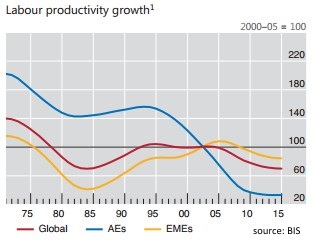This economic graph is maybe the most important in the last decade. Service prices are rising, while goods prices have steadily fallen. The main reason for us is the possibility to outsource big parts of the durables supply-chain to China and East Asia. This is where productivity growth happens. Prices of services, however, are ever increasing.
Marc Chandler writes about the increasing prices of services:
|
|
What Chandler omits is that rents and the housing boom are the biggest driver of the rising prices in services.
Productivity Growth only in AsiaThe second piece of economic data is that productivity growth that only happens in the Emerging Markets, in Asia in particular. The graph from the Bank of International Settlement shows that
|
 |
Full story here Are you the author? Previous post See more for Next post
Tags: Great Graphic,inflation,newslettersent,Surplus Capital,U.S. Consumer Spending

































